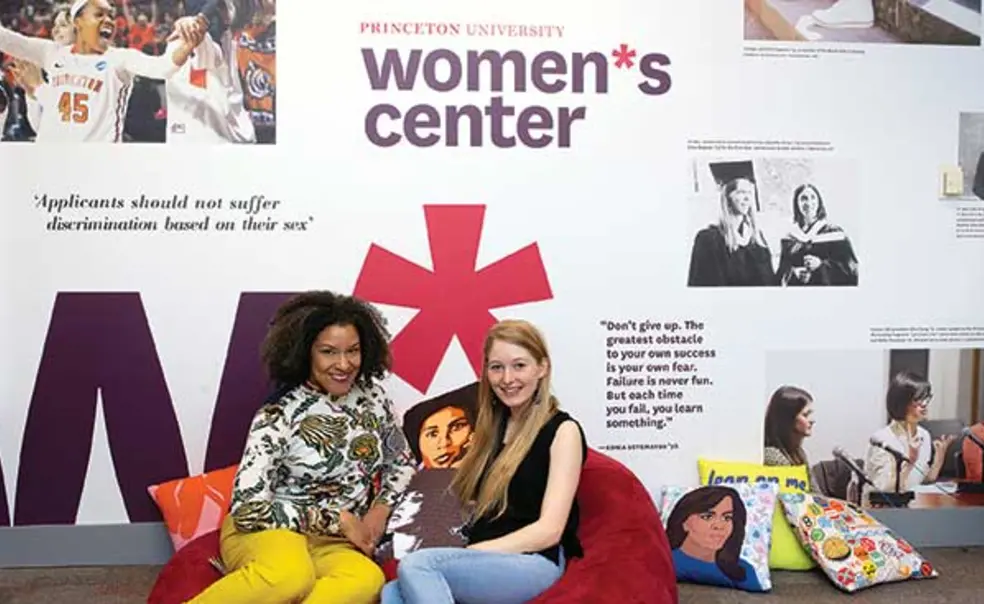A ‘Sense of Belonging’
Increased University support boosts visibility, impact of identity-based centers
The transition to college wasn’t easy for Tamica Perera ’22. A first-generation college student from Las Vegas, Perera excelled in high school, but she knew she’d be taking classes with students who had attended elite private high schools, and she was feeling self-conscious.
She heard about the Princeton University Mentoring Program (PUMP) a few weeks after arriving on campus. Offered through the Carl A. Fields Center, PUMP is a program designed to help first-year students of color acclimate to campus life by pairing them with older students who serve as mentors.
Perera said her mentor, Haydon John ’21, has helped her navigate everything from academic life to the culture of the Street. “She has been through the same adjustment period, so she understands what I’m going through — she has that wisdom and knowledge,” Perera said.
PUMP is one of many initiatives that have taken shape over the past several years as Princeton’s student body has continued to diversify and more resources have been devoted to the University’s three identity-based centers: the Fields Center, founded in 1971 as the Third World Center and now located in the former Elm Club at 58 Prospect Ave.; the LGBT Center, founded in 2006, in Frist Campus Center; and the Women’s Center, founded in 1971, also in Frist.
In 2015, a task force on diversity, equity, and inclusion recommended that the University hire more administrators to focus on diversity and inclusion and expand funding for the three centers and identity-based student groups. All three centers have been renovated, and all have seen an increase in student engagement and programming.
Tennille Haynes, director of the Fields Center, estimated that the center offers 10 to 15 more events each semester than it did five years ago. The Fields Center has also created a fellows program and identity-based graduation celebrations for students who identify as Native American, Middle Eastern and North African, and Asian Pacific Islander and Desi American (South Asia region).
Last year, the Women’s Center partnered with 18 student organizations, seven academic departments, and 30 University offices, said Amada Sandoval, director of the center, and it has tripled the number of its ongoing programs.
The Women’s Center has also been an incubator for gender-related student organizations. When Katherine Fleming ’19 arrived on campus, she and her friends began meeting informally in the center to discuss experiences of sexism on campus and the larger political climate. The group, Princeton Students for Gender Equality, benefited from support from the Women’s Center in its early stages and became recognized by the University, Fleming said.
“There are some spaces on campus where you can feel the legacy of Princeton as a very male institution — like when you go into certain rooms, and all of the portraits are of men,” Fleming said. “The Women’s Center is sort of a counter to all of those spaces that feel very male-centered. And it also reminds us that some of these alumnae that we all think of as superstars were once just like us as undergraduates here.”
The Women’s Center sponsored a number of activities in the spring semester to mark the 50th anniversary of undergraduate women at Princeton, including a mixer during Reunions of women from the classes of 1970–73 and this year’s graduates, and a poster campaign celebrating important events and “firsts” for women at Princeton. Seniors received commemorative 50th-anniversary stoles to wear over their graduation gowns.
The LGBT Center recently revamped its Q’nnections mentorship program, in which “families” of 10 to 12 undergraduates, grad students, faculty, and staff meet at least once a month for dinner and conversation. This year the center held its first “Hack the Drag” event: Students worked for 48 hours to design drag costumes with programmable lights and other sensors. The event concluded with a drag-show performance open to the community, said LGBT Center director Judy Jarvis.
“Our visibility and impact have significantly increased on campus,” Jarvis said.
Three years ago, the directors of the three centers teamed up to create a freshman-orientation program as an alternative to Community Action and Outdoor Action. Called Dialogue and Difference in Action, the five-day program gives incoming students the opportunity to discuss issues of identity, power, privilege, and difference within the Princeton community and society at large.
“Diversity and inclusion and social justice is not just about a black/white binary, and it’s not just about race and ethnicity,” said Haynes. “It’s about the culmination of a lot of different things — gender, sexuality, ageism, ethnicity, language, and about international identity.”
LaTanya Buck, who came to Princeton in 2016 as its first dean for diversity and inclusion, said more campus groups and departments are requesting cultural-training workshops. In addition, she said, more students, faculty, and staff are participating in mentoring programs.
Buck said the centers “play a critical role when it comes to student support, success, and sense of belonging. I see them as equally important for not just the particular student populations [that they target], but also for the broad student body.”
A prime example, she said, is the LGBT Center’s Oral Histories Project, in which students interviewed alumni about their experiences.
“Sometimes as a student here, you can get caught up in the fact that there are some not-so-great parts about this school and its history,” said TJ Smith ’20, who worked on the project as a research assistant. “But it has progressed, which gives me something to be hopeful about. And being a part of this project means that I feel like I’m contributing to that.”












No responses yet